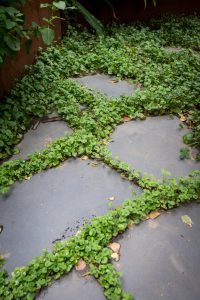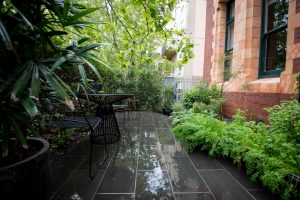Sustainable paving
There are more outdoor paving options than you may think, and environmental and financial costs can be high. Careful consideration should be taken for hard- wearing surfaces with timeless appeal.
Planning the hard landscaping or built components of your garden may present many of the same dilemmas faced when building or renovating. Just as you might scrutinise the source, embodied energy and durability of your building materials, you should apply the same eagle eye to your paving choices. The purpose of the paving will obviously also influence your choice of product, and of course aesthetic is essential. If it doesn’t look good, its likely to be removed and replaced down the track with additional financial and environmental costs.
Your materials choice should be influenced by both the style of the building and what’s already in your garden. The garden should be an extension of the building it surrounds, and for the two to complement each other there needs to be continuity, both in the materials used and the and the landscape design. For example, a brick house or a house with brick detail in the finish, could see this detail replicated through the paving. This could be in the form of a border for a gravel driveway or concrete paved space, or could be woven throughout the other elements as a pattern. You should be able to match your brickwork through a recycling yard or manufacturer with relative ease.
Aside from design issues, there is also the practicality of the material to be used the permeability of the base. A permeable base, which which allows rainfall to soak into the ground, is preferable. The increasing amount of impermeable hard surfacing in our cities and suburbs has an impact on surface water flooding and river pollution, and can also reduce ground water levels with wider ecological impacts.
The source of the materials used is also important. Most landscaping materials have come out of the ground at some stage, so we need to consider the where, what and how versus the longevity of the finished product. As with all building products, opting for recycled materials can help reduce demand for the virgin product. Transport miles from quarries to distribution centres and to the site should also be considered. For more sustainable tips, see www.aila.org.au/materials
Extract of article that first appeared in Sanctuary Magazine issue 28 words by Kate Smalley – Small Spaces Garden Design, Managing director.
